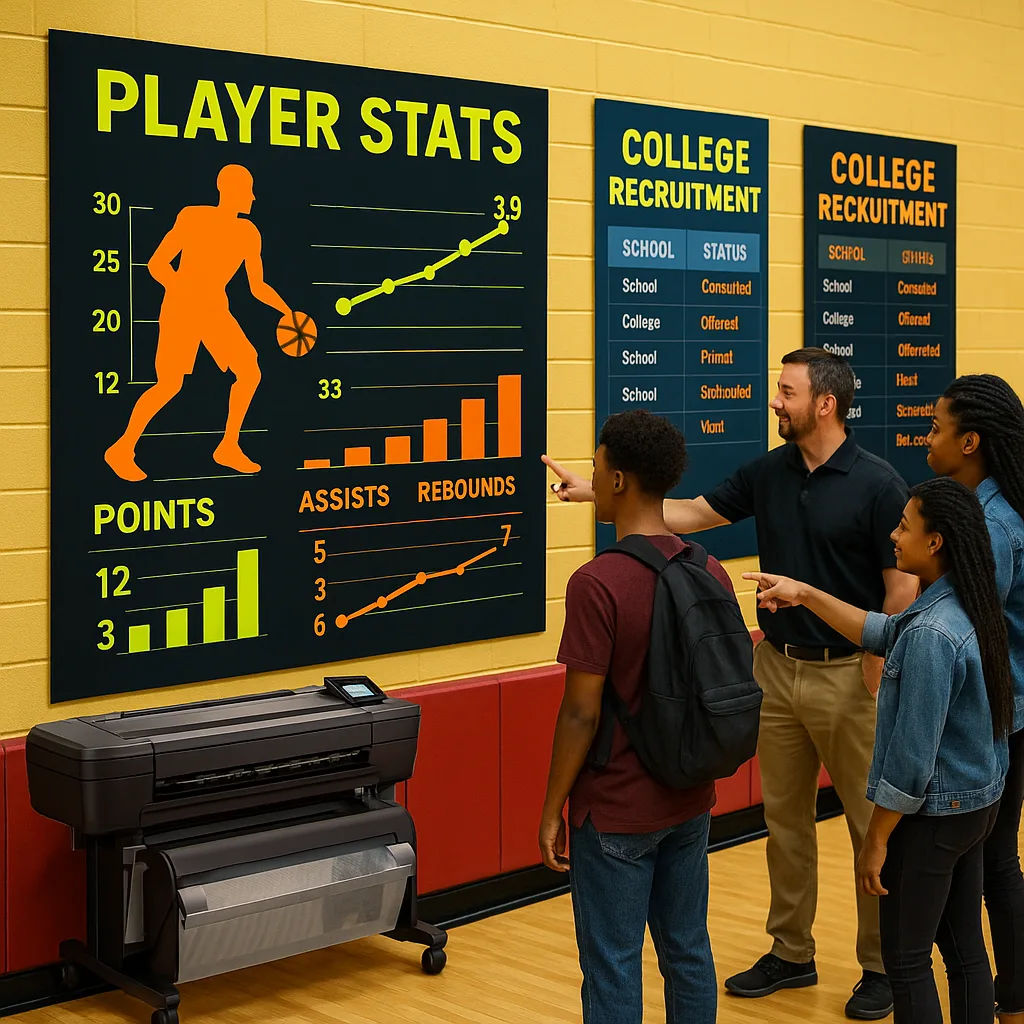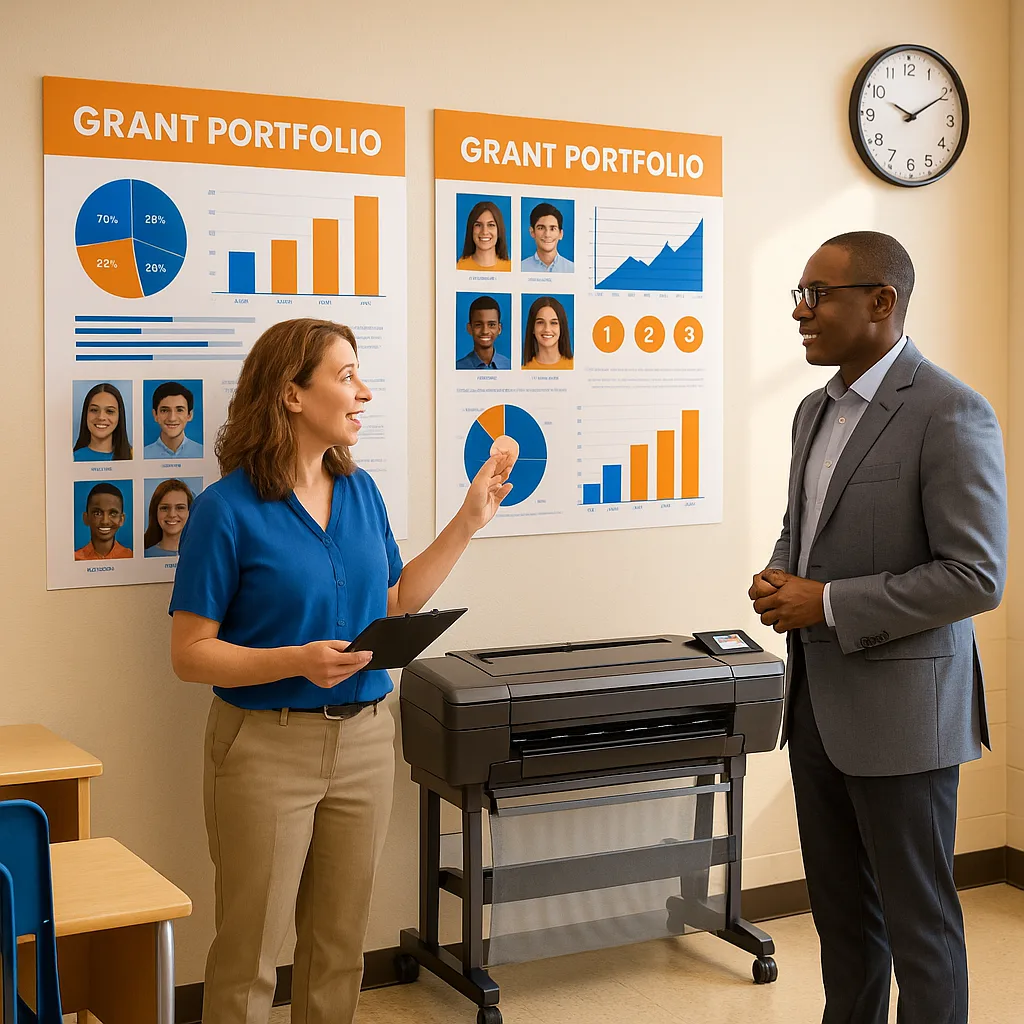
Okay, let’s be real—stepping into your first classroom is equal parts exciting and terrifying. Three months ago, I walked into my rural Title I first-grade classroom with a Pinterest board full of dreams and a budget that made me laugh-cry. Now, halfway through the year, I’ve discovered that having access to a poster maker machine for new teachers has become my secret weapon for surviving (and actually thriving) in Room 12.
Why Visual Learning Saves First-Year Teachers
Research shows that 65% of people are visual learners, but here’s what they don’t tell you in teacher prep—your six-year-olds will literally forget where their cubby is without a visual cue. Furthermore, studies from the National Association for the Education of Young Children indicate that consistent visual supports reduce classroom disruptions by up to 40%. That’s 40% fewer times I have to stop mid-sentence because someone forgot our bathroom procedure!
Having a classroom poster maker changed everything for me. Instead of spending my entire paycheck at the teacher store (guilty), I can create exactly what my students need, when they need it. Last week, three new ELL students joined our class—within an hour, I had bilingual schedule cards printed and laminated.
Quick-Start Poster Maker Machine for New Teachers
Before diving into the poster ideas, let me share what I wish someone had told me: you don’t need to be a design wizard. Moreover, Poster Studio Express offers lifetime design support, which means when I email them my chicken-scratch sketch at 10 PM, they send back a professional poster file by morning. Game-changer.
The Education Express 24 Desktop Poster Printer fits perfectly on my back counter. Additionally, it connects wirelessly to my laptop, so I can print from my desk while managing guided reading groups. The cost per poster? About $1.30—less than a school lunch.

Essential Classroom Management Posters (0-15 Minutes Each)
Morning Routine Visual Schedule
This was my first creation, and it’s still the MVP of my classroom. I photographed each morning task (hanging backpacks, turning in folders, choosing lunch) and created a numbered sequence. Subsequently, my “I don’t know what to do” chorus disappeared overnight.
Design tip: Use a consistent background color (I chose calming blue based on classroom environment research) and number each step boldly. Therefore, even pre-readers can follow along independently.
Voice Level Chart
Forget cute animals—my students needed concrete examples. I photographed them demonstrating each voice level:
– Level 0: Silent (library photo)
– Level 1: Whisper (partner reading)
– Level 2: Table talk (math centers)
– Level 3: Presenter (sharing chair)
– Level 4: Outside (recess)
Consequently, when I hold up two fingers, they instantly adjust without me saying a word.
Bathroom Sign-Out System
Real talk: bathroom management almost broke me in September. Now I have a simple poster with pockets—students move their name card when they leave. As a result, I always know who’s out, and they’ve stopped asking “Can I go?”
Daily Routine Posters That Actually Work
Interactive Calendar Display
Instead of buying expensive calendar sets, I created reusable pieces with my poster maker machine. Weather cards feature real photos from our playground (engagement through the roof!). Furthermore, I laminated everything with the PSE Cool 25″ Cold Laminator—another first-year essential.
Center Rotation Wheel
Pinterest had me making elaborate center charts that took entire weekends. Reality check: simple works better. Therefore, I created a basic wheel with color-coded sections matching table groups. Students check the wheel, grab their materials, and go.
Honest moment: My first version was too small. Kids crowded and pushed. Version 2.0 is poster-sized and mounted at their eye level. Sometimes you have to fail forward.
Clean-Up Job Chart
Every child needs a job, but remembering who does what? Nightmare. My solution: photos of each area with velcro spaces for name cards. Line leader, pencil sharpener, library organizer—everyone has a purpose. Subsequently, clean-up time dropped from 15 minutes of chaos to 5 minutes of productivity.
Curriculum Support Visuals (Under 30 Minutes)
Word Wall Headers
Instead of store-bought letters, I created headers matching our phonics program fonts. This consistency matters—research from the Reading Rockets initiative shows that font consistency improves letter recognition by 30% in beginning readers.
Math Strategy Posters
“How do I solve this?” echoed constantly until I created strategy posters for each unit:
– Counting on (with finger visual)
– Making 10 (ten frame illustration)
– Doubles facts (with mirror image)
Additionally, I print these on Satin Photo Paper for durability without laminating—budget win!
Science Vocabulary Cards
Each unit gets its own set. Pictures come from our actual experiments (nothing beats seeing yourself in teaching materials). For instance, our plant unit features photos of our class garden, with vocabulary like “stem,” “roots,” and “leaves” labeled clearly.
Social-Emotional Learning Displays
Calm-Down Corner Posters
Based on UNICEF’s educator toolkit recommendations, I created:
– Breathing technique visuals (birthday candles, flower sniffing)
– Emotion identification chart with real student faces (with permission)
– Coping strategy choices
The mint green color scheme wasn’t random—color psychology research suggests it promotes focus and calm. Since implementing these, meltdowns decreased while self-regulation increased.
Kindness Challenge Board
Weekly challenges with visual examples:
– Include someone new at recess (playground photo)
– Help a friend with supplies (sharing crayons)
– Use kind words (speech bubble examples)
Furthermore, students suggested additions, making it truly theirs.
Growth Mindset Reminders
“I can’t do this YET”—the most powerful three letters in education. Simple posters with student quotes about overcoming challenges. Moreover, featuring their actual handwriting makes it authentic and relatable.
Time-Saving Design Tips from the Trenches
After three months of daily poster creation, here’s what actually works:
Keep templates simple: Fancy borders eat printing ink and distract young learners. Therefore, I use clean designs with one accent color.
Size matters: Test viewing distance first. That “perfect” poster might be invisible from the carpet. Consequently, I now create everything at least 18×24 inches.
Batch similar projects: Friday planning includes listing next week’s visual needs. Subsequently, I design and print everything in one session.
Student photos engage: Nothing captures attention like seeing themselves. However, always get written permission first.
Laminate strategically: High-touch items only. Otherwise, the satin paper holds up surprisingly well.
Real Classroom Success Stories
Last month, our principal visited during centers. She asked how I managed such smooth transitions with 24 six-year-olds. The answer? Visual supports everywhere. She later ordered a classroom poster maker for each grade level.
My favorite success? Marcus, who struggled with routine changes, now confidently checks our visual schedule independently. His mom tearfully thanked me at conferences—he’s using similar visuals at home now.
Another win: Our ELL families feel more connected. Because I can quickly create bilingual materials, parents understand classroom expectations. Therefore, homework completion jumped from 60% to 95%.
Making It Sustainable
Here’s the truth—you can’t create everything at once. Start with your biggest pain point. For me, that was morning routines. Once that smoothed out, I tackled centers. Then behavior management. Building incrementally prevents overwhelm.
Budget reality: My district provides $200 for classroom supplies. Laughable, right? However, with poster costs around $1.30 each, I’ve created over 50 essential visuals for less than $70. Compare that to commercial posters at $15-25 each.
Consider forming a grade-level team. We share design files and split specialty paper costs. Additionally, Poster Studio Express’s design service creates templates we all customize. Collaboration makes everything manageable.
Your First-Year Visual Toolkit Action Plan
Ready to transform your classroom? Here’s your week-by-week plan:
Week 1: Create morning routine and voice level posters
Week 2: Design center rotation and clean-up charts
Week 3: Develop curriculum support for current unit
Week 4: Add social-emotional learning displays
Remember, perfect is the enemy of done. Your handwritten poster that students can read beats a Pinterest-perfect creation they ignore.
Looking Ahead
Six months from now, you’ll wonder how you survived without a poster maker machine. More importantly, your students will have the visual supports they need to succeed independently. That’s the real magic—when they stop asking “What do I do?” because the answer is right there on the wall.
Teaching is hard. First-year teaching in a Title I school? Even harder. But with the right tools and realistic expectations, you can create a classroom environment where everyone thrives. Furthermore, when you’re printing professional-quality materials at school instead of spending weekends at the copy shop, you might actually have time for that self-care everyone mentions.
Ready to revolutionize your classroom? Call Poster Studio Express at 866-788-7900 to discuss which poster maker package fits your needs. Trust me, your future self (and your students) will thank you.







